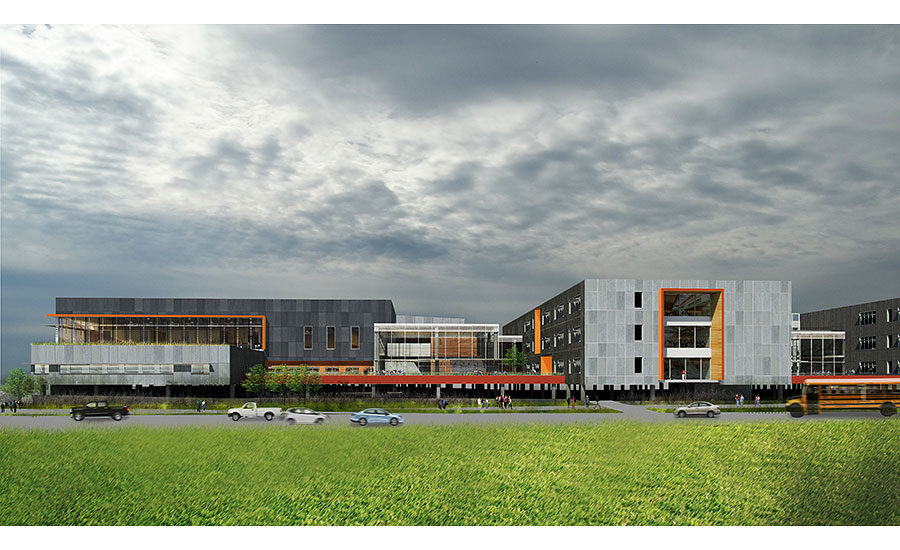On the Boards: Schools of the 21st Century
Four ongoing projects address diverse educational needs.

Mount Si High School Redevelopment, Washington NAC Architecture
Located 45 minutes outside Seattle, Mount Si High School nests in the shadow of its namesake mountain—as well as within the floodway of a river. To respond to those natural conditions, NAC Architecture’s redesigned school will be elevated above flood levels, not only safeguarding the facilities but also maximizing views of the mountain range. The 350,000-square-foot project will stitch together four three-story academic buildings, a performing-arts center, and a gymnasium. As a carryover from the school’s current layout, the new complex will include a building just for ninth graders, called the Freshman Campus.
The new buildings will stand on what are now baseball fields and a parking lot, allowing the existing facilities to remain open when construction begins in 2017. The building is scheduled to be 85 percent completed and occupied by fall 2019, with the remaining site work complete by December 2020.
Image courtesy NAC Architecture

French International School, Tseung Kwan O Campus, Hong Kong Henning Larsen Architects
With four campuses already sprinkled throughout the city, the French International School strives to be a hub for French culture in Hong Kong. The newest campus, designed by the Denmark-based Henning Larsen Architects and expected to be complete by fall 2018, will serve 1,050 students in kindergarten through middle school, in addition to opening up for public events on evenings and weekends. The 18,000-square-meter complex will capitalize on flexible open-plan layouts and ample outdoor space. The groundlevel will house the school’s 300-seat auditorium, 600-seat cafeteria, and kindergarten, while two elevated bars will harbor the primary and middle schools. The middle school building will also contain a gymnasium and swimming pool.
Especially compelling will be the 1,000 colored ceramic tile frames, each customized by a student, that will comprise the facade of the campus’s main entrance. Glazing within the frames will diffuse daylight into the gymnasium. According to the architects, these tiles symbolize the school’s diversity and spotlight how individual students will shape the school’s future.
Image Courtesy Henning Larsen Architects

Središće Educational Complex, Zagreb, Croatia Flansburgh Architects
A compact, monolithic aesthetic will unify three schools within the Središće Educational Complex in Croatia: the American International School of Zagreb, a Croatian kindergarten, and an elementary school. Boston-based Flansburgh Architects and the Zagreb firm Sangrab+AVP won an international competition last October to design the complex. It is rare to find a private international school alongside two public schools; according to Flansburgh president David Croteau, this unusual consortium arose from the city’s desire to boost international relations while serving local educational priorities.
The architects aim to celebrate the schools’ common educational goals while tailoring the design of each to the needs of distinct age groups and teaching methods. The scheme of the international school—a private school with an American style curriculum—minimizes lecture-style spaces, with glass walls visually connecting classrooms to common areas; the Croatian elementary school will feature more self-contained classrooms.
Forming a straight line along the eastern edge of the site, the three buildings will be organized around inner courtyards, with a promenade separating the international school from the two local schools. Each roof will be covered by photovoltaic panels, intended to supply 100 percent of the schools’ heating and cooling energy. Sports fields along the site’s western edge will provide a buffer between the schools and adjacent 10-story residential buildings. Construction is anticipated to begin in fall 2016 and be completed by fall 2017.
Image courtesy Flansburgh Architects

Riverdale Country School, New York City Architecture Research Office
The younger students of Riverdale Country School, a private pre-K–12 school in the Bronx, have plenty of breathing room on an eight-acre campus that dips toward the Hudson River. But the school’s 1960s-era Perkins Building, which housed a theater along with fourth- and fifth-grade classrooms, had a stifling layout that didn’t match the school’s ethos of collaborative learning. Architecture Research Office’s (ARO) design for a replacement on the site of its predecessor features a central corridor to streamline access throughout. ARO worked with Mathews Nielsen Landscape Architects to contend with a sloping construction site.
Clad in zinc and blue-toned concrete panels, the two-story, 23,000-square-foot building will be anchored by a theater on one side and a cafeteria on the other. ARO is collaborating with design studio Open on graphics that will function as pedagogical tools throughout the building, such as a series of skylights that will illustrate cardinal directions and the color spectrum as well as other sunlight-inspired lessons.
Image courtesy Architecture Research Office
[RELATED] Happy Trailers: ARO makes the best of a temporary site with bright graphics and playful design.
Copyright ©2024. All Rights Reserved BNP Media.
Design, CMS, Hosting & Web Development :: ePublishing